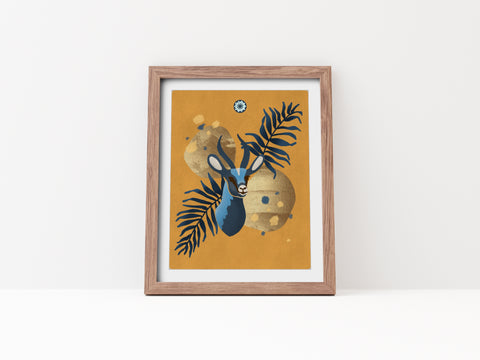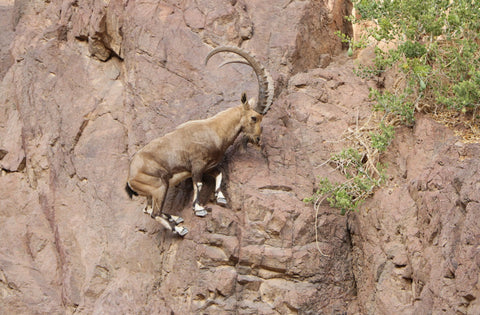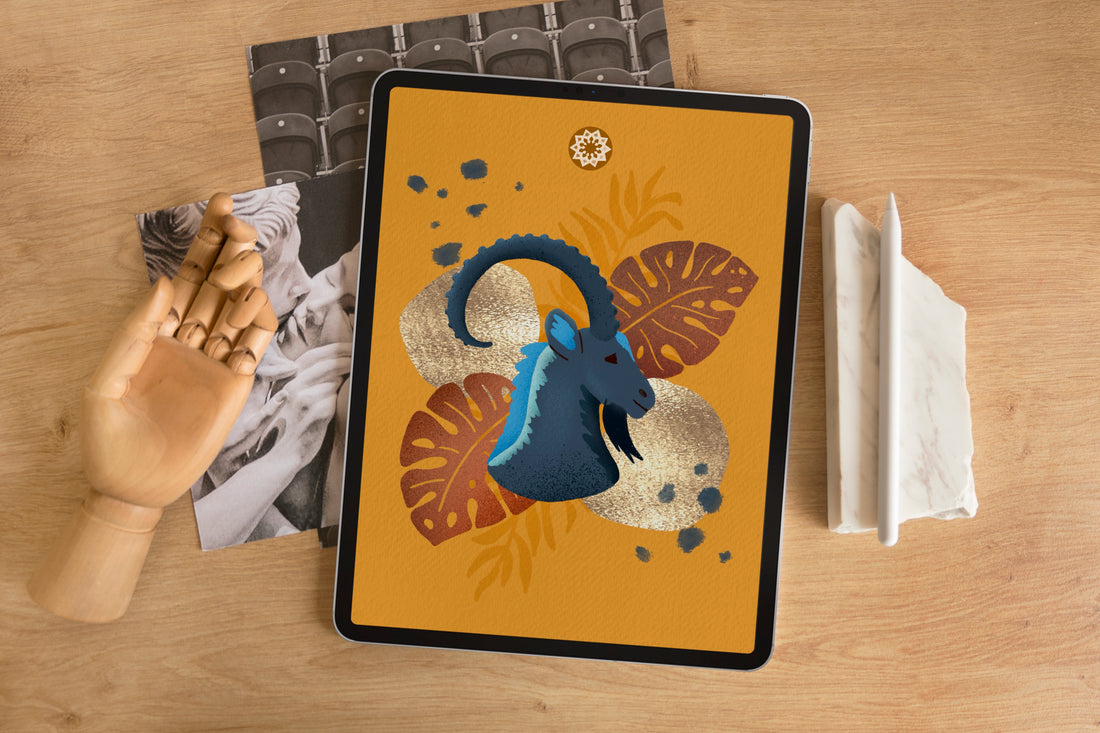In the latest addition to the Arabian Wildlife collection, a new artwork featuring the Arabian Nubian Ibex has been released. This piece aims to spotlight the unique biodiversity within Saudi Arabia, with a particular focus on species that are critically endangered, endangered, or vulnerable. The Arabian Nubian Ibex, a species currently facing challenges due to environmental pressures and human activities, stands as a poignant emblem in this narrative.
The Arabian Nubian Ibex, native to the mountainous regions of Saudi Arabia, plays a crucial role in the region's ecological balance. Historically respected and featured in ancient art and folklore, it is now listed as vulnerable, highlighting the need for urgent conservation measures (Ibex - Arabian Rock Art Heritage](https://saudi-archaeology.com/subjects/ibex/). The decline in their population due to factors such as habitat destruction and illegal hunting calls for immediate attention and action.

The Arabian Gazelle - listed as a Vulnerable Species - is another artwork from the Arabian Wildlife Collection
This artwork is not just a representation; it's a call to action and awareness. It serves as a reminder of the fragile beauty that dwells within the kingdom and underscores the importance of conservation efforts. By including the Arabian Nubian Ibex in the Arabian Wildlife collection, the message extends beyond mere appreciation of natural beauty. It aims to deepen the understanding of the urgent need for wildlife conservation and to foster a sense of responsibility among individuals and communities towards the environment.
The integration of the Arabian Nubian Ibex into this artistic endeavor is strategic. It represents a bridge between cultural heritage and modern conservation challenges, offering a narrative that is both informative and compelling. This narrative is designed to inspire viewers not only to admire the aesthetic qualities of the artwork but also to reflect on their personal or collective impact on the environment and the steps they can take towards its preservation.

Another Nubian Ibex Artwork featuring an interpretation of the petroglyphs found across Saudi Arabia
There are currently conservation efforts in Saudi Arabia aimed at preserving the Nubian Ibex. These efforts include the creation of special ibex reserves to protect their habitat from the pressures of hunting and habitat degradation. The conservation measures seek to maintain the ibex population and ensure their survival in the region.
Likewise, the Royal Commission for AlUla has initiated a large-scale release project as part of the region's largest regeneration effort. This project has seen the reintroduction of more than 1,500 endangered animals into their native habitat in Saudi Arabia, including the Arabian oryx, sand gazelles, and the Nubian ibex. The initiative aims to restore native animal species and promote habitat regeneration in north-west Saudi Arabia. The animals released are monitored with satellite tracking collars to study their adaptation and movement in the wild, contributing to ongoing conservation research and efforts (Distribution and status of Nubian ibex in Saudi Arabia | Oryx | Cambridge Core](https://www.cambridge.org/core/journals/oryx/article/distribution-and-status-of-nubian-ibex-in-saudi-arabia/FB7122ACC934B72493E925574F8419CB).
These actions reflect Saudi Arabia's commitment to biodiversity restoration and conservation, aiming to balance development with ecological sustainability.

The Arabian Leopard Artwork - Listed as a critically endangered species with only approx. 200 Arabian leopards in the wild.
To assist these efforts, this collection serves as an educational tool, shedding light on the lesser-known species of Saudi Arabia and the specific threats they face. Through art, we can reach a wide audience, transcending language and cultural barriers, to promote a universal message of conservation. The Arabian Nubian Ibex, with its majestic presence and symbolic significance, serves as the perfect ambassador for this cause.
As part of the broader Arabian Wildlife collection, this new artwork invites viewers on a journey through the rich biodiversity of Saudi Arabia. It encourages them to explore the wider context of each species’ habitat, behavior, and conservation status. By doing so, it aims to cultivate a deeper appreciation for the natural world and a stronger commitment to its protection.

The Arabian Wildlife collection, with its latest addition featuring the Arabian Nubian Ibex, stands as a testament to the power of art in raising awareness and driving change. It is a call to action for conservation, urging us to ensure that the beauty and diversity of our natural world are preserved for generations to come. Through this collection, we are reminded of the critical role each species plays in the ecological balance and the shared responsibility we hold in safeguarding our planet's future.
Next in the Arabian Wildlife collection will be the Arabian Oryx, the animal behind the legend of the unicorn!
Would you like to assist in the conservation of Arabian wildlife, including efforts to preserve the Nubian Ibex. The International Union for Conservation of Nature (IUCN) has partnered with the Saudi Wildlife Authority (SWA) to advance nature conservation initiatives in Saudi Arabia. This collaboration aims to enhance biodiversity protection and management of protected areas, bringing Saudi experiences to the international conservation community. Through initiatives like the IUCN Green List of Protected and Conserved Areas, the partnership seeks to demonstrate tangible conservation results in Saudi Arabia's nature reserves.

Additionally, the Royal Commission for AlUla (RCU) has joined forces with Panthera, the global wild cat conservation organization, under the Arabian Leopard Initiative. This partnership is committed to the conservation of the critically endangered Arabian leopard, with implications for broader wildlife conservation efforts in the region, including the Nubian ibex. The initiative encompasses scientific research, community-based conservation projects, and habitat restoration. The RCU has pledged significant funds to support these conservation initiatives, not only for leopards but also for other native species such as the Nubian Ibex (Transforming Nature Conservation in Saudi Arabia | IUCN](https://www.iucn.org/news/protected-areas/201901/transforming-nature-conservation-saudi-arabia).
Individuals looking to support these efforts can consider donating to organizations like Panthera or participating in programs and initiatives led by the Saudi Wildlife Authority or the Royal Commission for AlUla. Engaging with these initiatives, whether through direct support, spreading awareness, or contributing to community-based projects, can make a significant impact on the conservation of Arabian wildlife.
For more information on how to get involved or make a donation, you can visit the websites of the IUCN and Panthera:
- IUCN: Transforming Nature Conservation in Saudi Arabia
- Panthera: Arabian Leopard Initiative
————
To continue the conversations, join my creative community, by subscribing HERE where you'll be kept up to date with new art, flash sales, freebies and more.
As always you can drop me a note below, or send me a DM on the Gram. Looking forward to hearing from you.
Eve xo (the artist at The Shamal)


